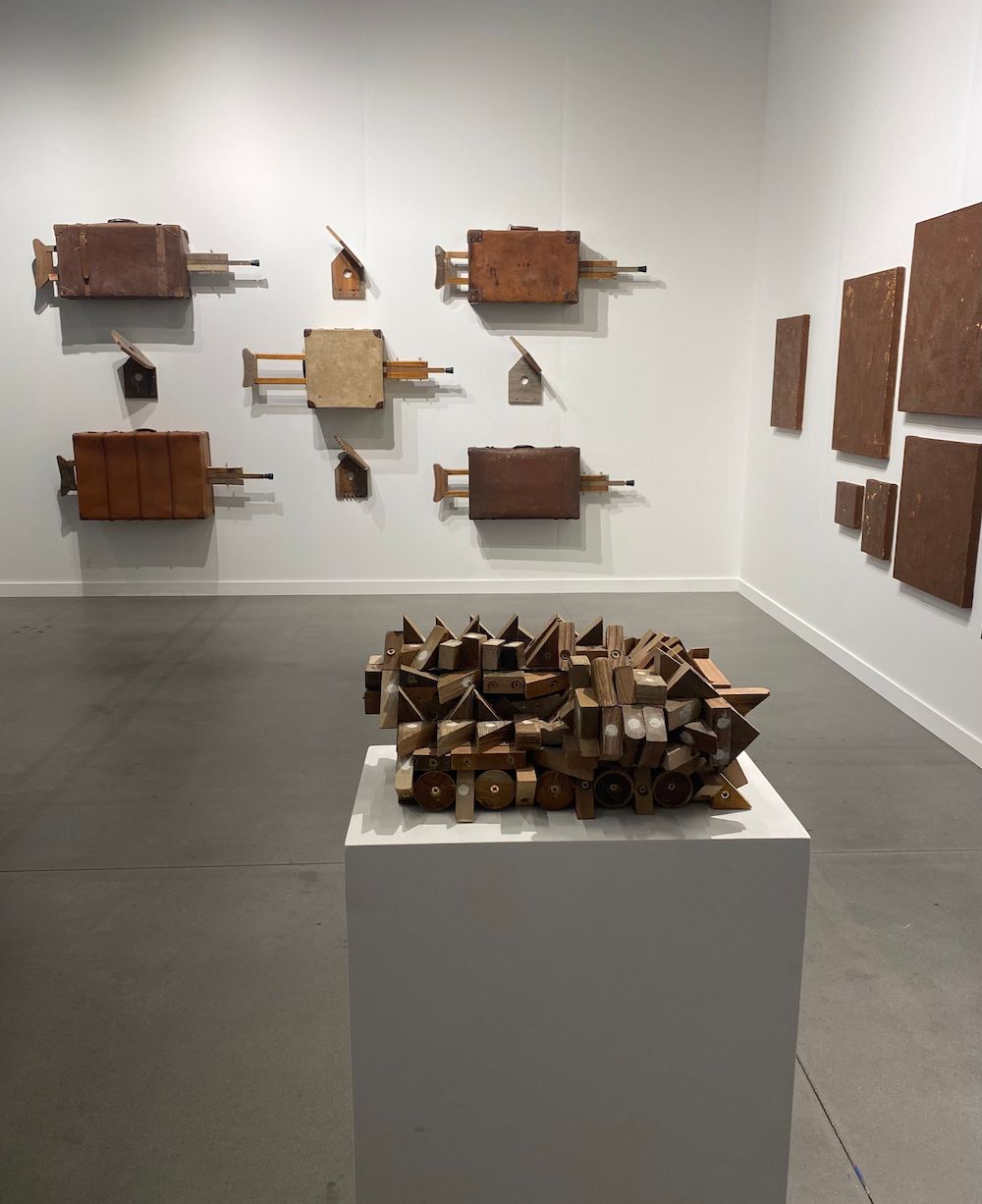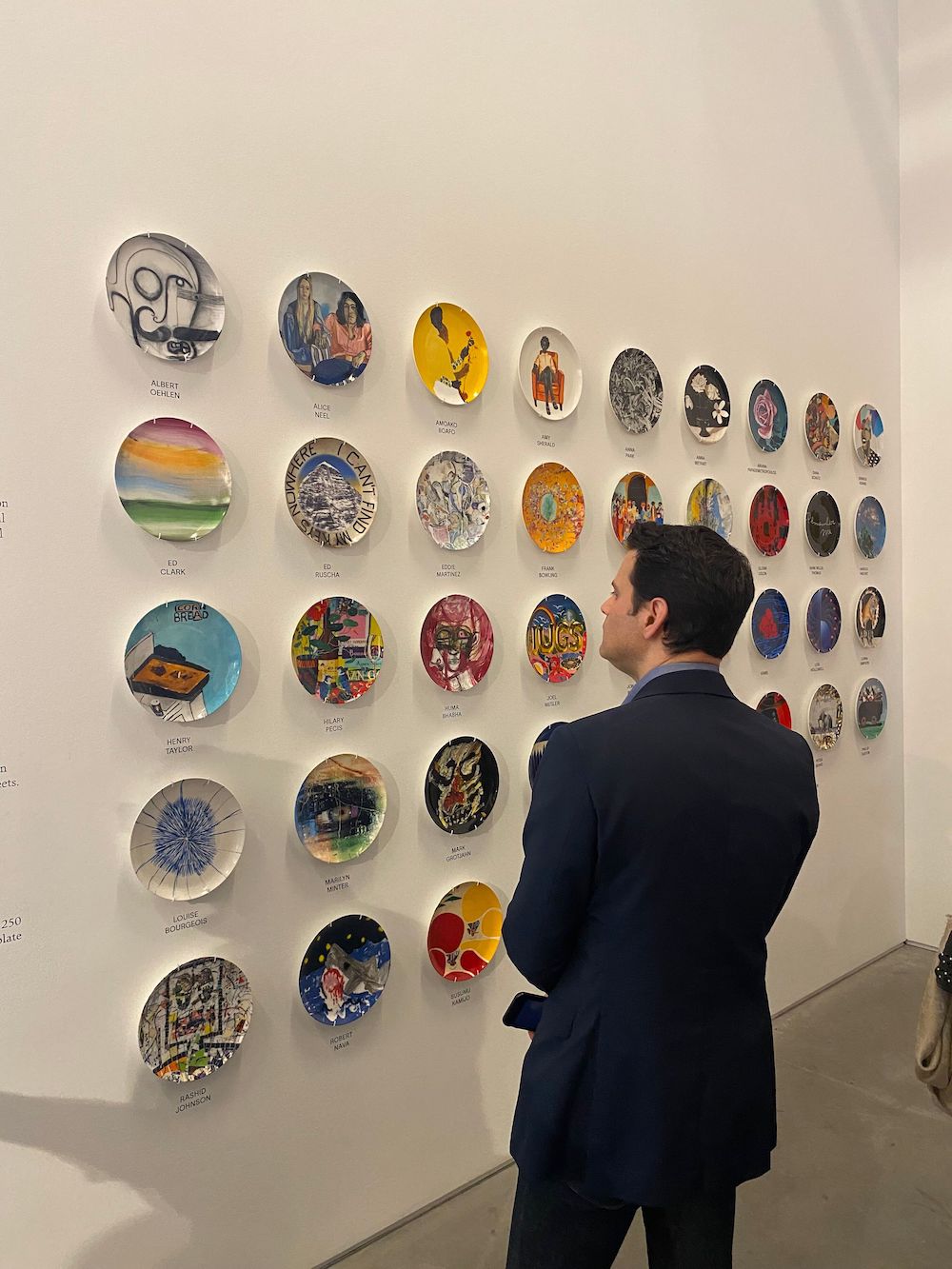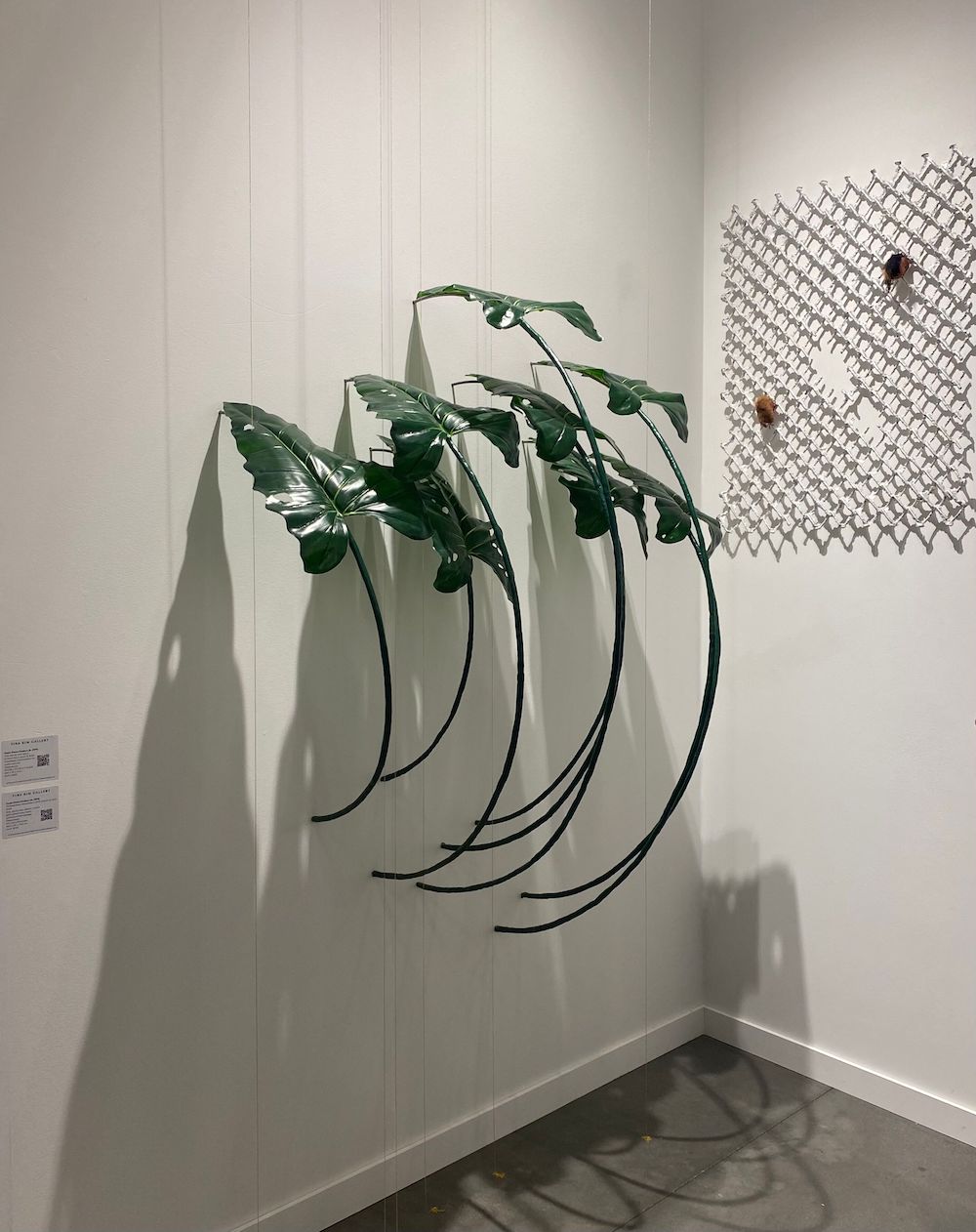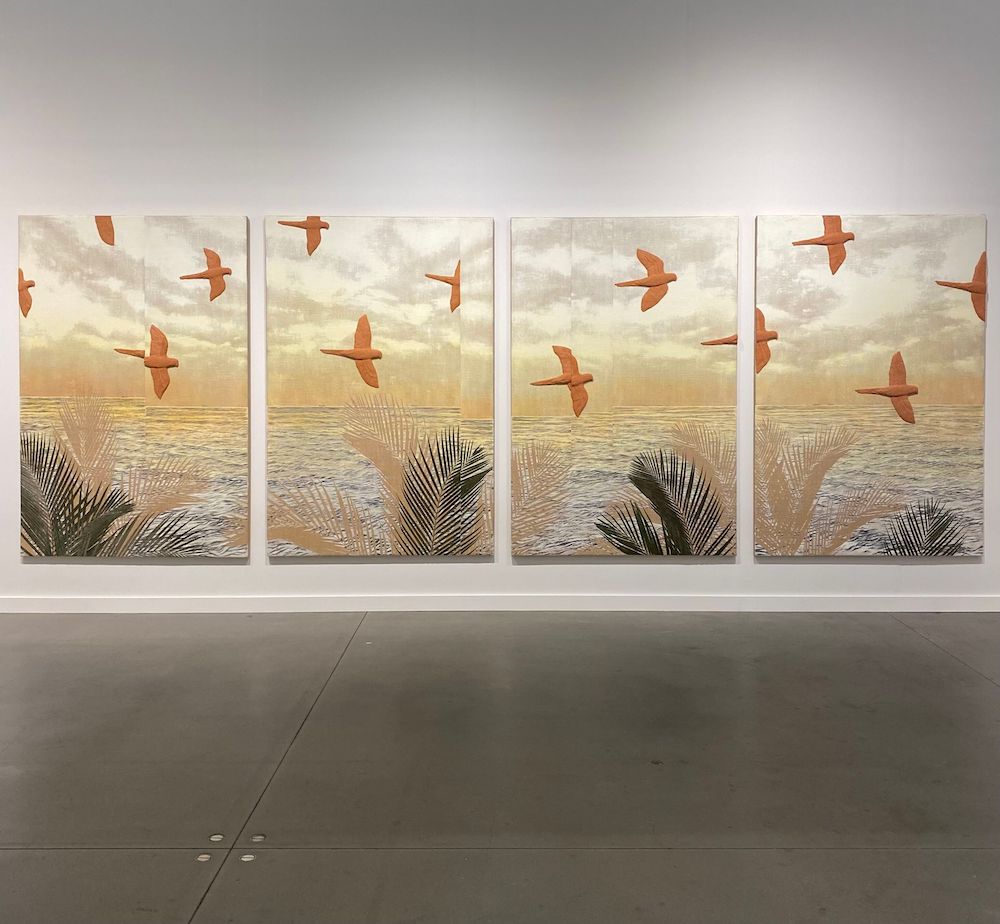The month of May in New York is nothing short of a combined marathon-sprint for the art industry. Fairs are popping up all over Manhattan, auctions are yielding conspicuous displays of excess wealth and galleries are staging buzzworthy exhibitions to attract the crowds. The nights are filled with dinners, parties, panels and everything in between. While Miami Art Week typically consists of one long week of events, New York’s May counterpart seemingly never ends. It started last week on the 10th with the opening of Future Fair and SPRING/BREAK, followed by Independent Art Fair and The European Fine Art Foundation (TEFAF) on the 11th and 12th.
Future Fair was a standout of Art Week Part One. The young fair brought endless abstraction and bold curatorial decisions. A standout was Trotter & Sholer’s booth presented with Melhop Gallery, which paired colorful, mixed-media paintings by Alex Stern with equally vibrant cotton embroidery on canvas by Stewart Francis Easton. The two bodies of work complemented each other in a way that made it hard to believe their practices weren’t previously intertwined. Though working in different mediums, the parallel colors, shapes and textures made each piece visually stronger and more dynamic—a remarkable reminder of the power of good curating and one of the few presentations that still sticks out a week later.

Trotter & Sholer and Melhop Gallery’s booth at Future Fair.
As Week Two begins, the fairs continue with New Art Dealers Alliance (NADA), 1-54, Volta, Clio and Frieze, each offering something different. As the anchor of the two-week stretch, Frieze presents the best opportunity to see a snapshot of the artists and galleries leading the industry. Opening May 17th to invited guests and running through the 21st, Frieze New York takes place in the upper stretches of Chelsea at The Shed. This year’s edition features over 60 exhibitors from 27 countries, including a strong coalition from nearby galleries across Chelsea and Tribeca.
Wednesday’s preview was packed with visitors. The expected curators, museum directors and collectors were seen along with the throngs of journalists, as well as influencers and pseudo art professionals—a surprising sign for the traditionally industry-focused VIP day. Maybe FOMO led everyone to visit early, or maybe the fair was so great no one wanted to leave, but there’s no doubt the first several hours were abuzz.

blank project and Proyectos Ultravioleta’s joint booth
A highlight from opening day were the colorful, mixed-media sculptures by Ann Veronica Janssens at Esther Schipper. With reflective surfaces, pops of vibrant color and gradients of rainbow hues, the presentation was an eye-catching crowd favorite. Reflective materials seem to be a common thread in this year’s fair, perhaps to engage the broader, Instagram-driven audience art fairs are starting to attract. Jean-Michel Othoniel’s mirrored surfaces popped up in a handful of booths, including Kukje Gallery and Perrotin Gallery. Nearby, David Kordansky Gallery treated its entire booth like a mirror, covering the walls in a reflective material that made the digital collages and gypsum-based engravings by Lauren Halsey appear to glow.
A slightly more subtle use of reflection could be found in Miguel Abreu Gallery’s booth, which impressed with a stunning selection of works by Scott Lyall. Made of a variety of materials including glass, mirror and gold particles, the ethereal paintings displayed hazy, meditative reflections of fairgoers. While fairs are inherently overwhelming and leave any visitor feeling like their art quota has been reached, Miguel Abreu’s booth did the exact opposite. I walked away wanting to see more.

Esther Schipper’s booth with Ann Veronica Janssens
Also pushing the boundaries of painting were several wall pieces that verged into the realm of sculpture with 3D, painterly compositions. In mor charpentier’s booth was a breathtaking, multi-panel work by Daniel Otero Torres featuring an orange sky above the Caribbean. Depicted across four panels, a closer look revealed that the birds flying along the coast are all raised from the surface. Taking a more apparent 3D form was the installation of suitcases by Kemang Wa Lehulere in blank project and Proyectos Ultravioleta’s joint booth. Hung like a geometric, abstract painting, the piece was in dialogue with Edgar Calel’s textured brown paintings on the adjacent wall.
Marking a poetic approach to the painting-sculpture dichotomy was Tina Kim Gallery, which presented a selection of its new and leading artists, including a beautiful new installation by Tania Pérez Córdova, as well as works from her recent show at Museo Tamayo. Using artificial leaves, the artist creates minimalist, yet highly powerful wall installations that invite viewers to consider the beauty of nature to inspire greater conversations on ecology and sustainability.

Massimo de Carlo’s booth with Sanford Biggers.
Further inviting visitors to examine the larger implications of visual and material culture was Massimo de Carlo, which presented a solo booth of new sculptural quilts by Sanford Biggers. In line with the artist’s practice, the colorful works are imbued with historical significances and symbolic references. Biggers used pre-1900 antique quilts, drawing attention to the legacy of quilt-making and the layers of meaning they have had for centuries, including their protective role as objects of comfort and warmth, as well as their rumored function of signaling safe spaces along the Underground Railroad.

Artist Plate Project
In addition to the exhibitors, Frieze featured a selection of special projects and nonprofits. A highlight was Artist Plate Project, an initiative in which renowned contemporary artists create limited edition plates to raise funds for Coalition for the Homeless. This year 40 artists participated, including Amy Sherald, Joel Mesler, Marilyn Minter and Mickalene Thomas, drawing undoubtedly the most eager buyers of the day who lined up in the dozens. The functional artworks are produced in editions of 250 and sold for $250 per plate, providing a unique opportunity to own a piece by leading artists (and one of the few affordable options at the fair). Each plate provides emergency relief funds and can feed over 100 people facing homelessness. Co-founded and curated by Michelle Hellman, Artist Plate Project has raised over $4.5 million since 2020 to support homeless people in New York.
As always, the influx of collectors, journalists, curators and dealers provides an ideal moment for brands to collaborate with the fairs. While across the board these can feel forced, a poetic partnership evolved between the champagne house Ruinart and artist Eva Jospin. Part of Ruinart’s Carte Blanche program in which artists are commissioned to reinterpret the house’s heritage, the residency culminated in a pop-up lounge at Frieze and an immersive, recycled-carboard exhibition under The High Line. In line with the artist and Ruinart’s ethos, the collaboration, titled PROMENADE(S), explores the intersection of art and sustainability. On view through June 9, visitors are invited to join free, docent-led tours in partnership with The High Line to learn about the importance of the urban public space and how they can contribute to a balanced, sustainable ecosystem. The collaboration was a welcome reminder to take a step outside the fair halls and enjoy the rare patch of green that the city has to offer.

Tania Pérez Córdova at Tina Kim Gallery
After a long first day of Frieze, a walk on The High Line and a glass of champagne sound ideal. Day One somehow feels like Day 20, yet many of the presentations on view were refreshing and inspired further research rather than fade into a blur. I, for one, look forward to seeing more of every artist featured above, though maybe after a healthy break from art fairs.
All photos by Annabel Keenan


